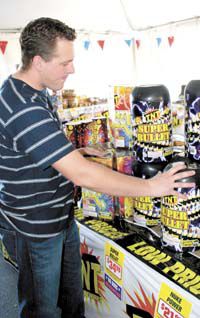| Jerad Upwall of Price Chapel’s youth ministries show his stock of fireworks just before the 4th of July celebration. |
With the July 4th around the corner, Price Fire Chief Paul Bedont reminds Carbon County residents of the dangers associated with the holiday during hot, dry weather conditions.
“Fire conditions in Carbon County are at extremely dangerous levels this year and caution should be used if you decide to discharge fireworks,” stated Bedont.
“Those residents who choose to purchase illegal fireworks outside of Utah and display them in Carbon County could find themselves receiving a costly citation,” warned the Price city official.
Bedont cautioned residents of the immediate and devastating effects fireworks can cause.
“Just last week, a home in Price city caught fire as a result of juveniles playing with illegal fireworks,” explained the chief.
According to Bedont, the following fireworks are acceptable for use, display and discharge in the Carbon County area within the designated dates:
•Approved class C common fireworks can be sold after June 19 and before July 26, after Dec. 19 and before Jan. 3 and 5 days before and on Chinese New Year.
•Approved class C common fireworks can only be legally discharged three days before, on the day of and three days after July 4th, July 24th, Jan. 1 and Chinese New Year.
Under Utah law, only approved class C common fireworks may be purchased and ignited.
While there are hundreds of approved fireworks, the incineary devices have several things in common.
Approved fireworks do not explode or leave the ground.
The sparks from the devises reach a maximum height of 15 feet.
The approved class C fireworks are legally sold at locations in Carbon County and across Utah
By statute, the unapproved fireworks and dangerous explosives are unlawful to sell, purchase, possess or discharge throughout Utah.
Only state licensed fireworks display operators are permitted to sell, purchase, possesses or discharge dangerous class C explosives.
Dangerous class C exdplosive items include firecrackers, cherry bombs or other similar devices.
| Legal Class “C” fireworks displayed at a local distributors shop. |
Skyrockets or bottle rockets which use combustible materials and rise more than 15 feet when discharged are also classified as dangerous explosives.
Aerial fireworks which which propel comets, shells, salutes, flash shells or similar devices that travel more than 15 feet into the air fall under the state prohibited category.
In addition, chasers, whistlers or other devices that travel more than 10 feet laterally on a smooth surface or exceeds 15 feet in height when discharged can not be legally discharged in Utah.
The dangerous class C fireworks are generally purchased outside of Utah and unlawfully transported into the state.
Bedont cautioned Carbon County residents that the unlawful possession and discharge of unapproved fireworks is a class B misdemeanor criminal offense.
Convictions can result in hefty fines and/or jail time.
Anyone discharging fireworks, whether legal or not, can also be held liable for any damages occurring as a result of the individual’s actions.
According to Bedont, enjoying the holiday in a safe manner is as simple as following several safety tips.
The precautionary measures include:
•The safest way to enjoy fireworks is to visit public displays put on by professionals who are licensed and know how to safely handle fireworks.
•When planning to use fireworks, people should make sure the items are legal in the area.
•People should never light fireworks indoors or near fields or open areas with dry brush.
Officials recommend only displaying fireworks in an area devoid of vegetation or combustibles.
•People should always have a bucket of water, hose line or a fire extinguisher nearby in case an emergency should occur.
In addition, people should know how to properly operate the fire extinguisher.
•People should never wear loose clothing while using fireworks.
The sparks can easily fall under clothing and cause burns.
•Occasionally, fireworks malfunction. Therefore, people discharging fireworks always take precaution to protect the eyes.
•People should always read the directions and warning labels printed on fireworks.
If the fireworks are not marked with the contents, directions and warning labels, people should not light the devices.
•Adults should always supervise children when fireworks are displayed.
Even sparklers can burn skin and leave permanent scarring and disfigurement.
“We hope all residents take appropriate measures to safely display their legal fireworks,” concluded Bedont. “Every year, there are hundreds of injuries and fires associated with fireworks. Please have a safe and fun Independence Day.”

